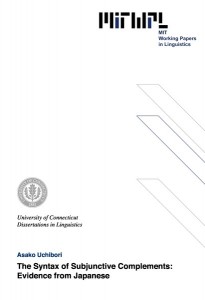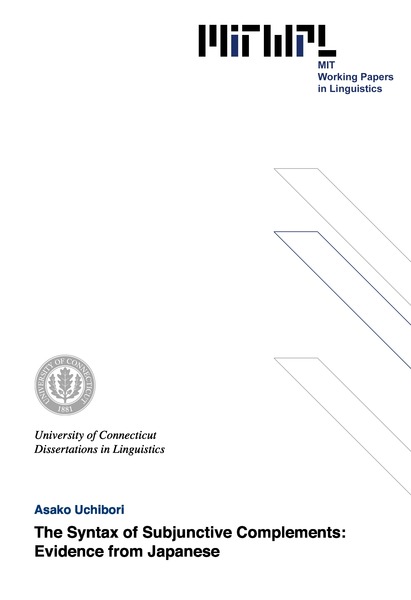The Syntax of Subjunctive Complements: Evidence from Japanese
A. Uchibori, 2000
This dissertation aims to present a syntactic analysis of seemingly problematic, but intriguing properties of the subjunctive complements in Japanese concerning Tense (T), Case for subjects, and the locality of A-scrambling, under the Minimalist Program pursued by Chomsky (1995, 1998, 1999)
Chapter 2 provides basic descriptions concerning the categorial status and the distribution of subjunctive clauses. I establish that the two forms, -yoo(ni-(to)) and -koto, are the subjunctive complementizers introducing finite clauses.
Chapter 3 discusses the Case properties of complement subjects and their control property. It is indicated that subject-to-subject raising takes place out of a certain type of subjunctive complement. It is also demonstrated that while only nominative Case is licensed for subjects in some other types of subjunctive complement, both nominative Case and null Case are actually available in the rest. I also discuss how the control property of empty subjects is related to interaction between the semantics of the governing verbs and the aspectual property of complement predicates.
The tense property of subjunctive complements is deeply investigated in Chapter 4. It is observed that T in a certain group of subjunctive complements is defective with respect to tense morphology, licensing of temporal adverbs, and tense interpretations of nonpast stative predicates. I point out that nominative Case and null Case are correlated with [+tense] feature and defective [-past] feature, respectively.
Chapter 5 presents two analyses of the fact that long-distance A-scrambling is allowed out of subjunctive CP complements, but not out of non-subjunctive CP complements. One analysis accounts for the case in which defective T occurs in the complement. Based on Chomsky's (1998, 1999) hypothesis concerning strong phases, I propose that CP of which head selects defective T does not count as a strong phase. The other analysis explains the case of the complement headed by -koto, in which complete T appears. Based on -koto's rich nominal property, I assume that the Spec of -koto is an A-/L-related position. Furthermore, it is suggested that V-to-T movement is not a necessary condition on A-scrambling and that A-scrambling is movement of a different kind from A'-scrambling.
Chapter 1 Introduction 1
1.1. A Problem: Transparency of Subjunctive Complements in
Japanese 1
1.2. An Overview of the Dissertation 6
Chapter 2 Preliminary Discussions: The Distributions and the
Categorial Status of -yoo(ni(to)) and -koto 10
2.1. -Yoo(ni(to)) 12
2.1.1. The Distribution 12
2.1.2. The Categorial Status as C0 29
2.2. -Koto 41
2.2.1. The Distribution 41
2.2.2. The Nominal Property of -koto as a Complementizer 44
Appentix 1: On a Certain Difference in Interpretation between
Subjunctive and Non-Subjunctive Relative Clauses 56
Chapter 3 Raising, Control, and Lexical and PRO/pro Subjects 58
3.1. Subject-to-Subject Raising 60
3.2. Lexical/Empty Subjects and the Control Requirement 79
3.2.1. Non-Control Type Complements 80
3.2.2. Nominative and pro Subjects 83
3.3. PRO Gate Effects 112
Chapter 4 The Tense Property and the Case properties of Subjects 136
4.1. [+/- Past] Tense 140
4.2. (In)dependent Tense 147
4.3. (Un)ambiguity of Nonpast Predicates 153
4.4. Mapping from Tense Features to Tense Structures 163
4.5. Correlation Between Tense Features and The Case Properties
for Subjects 183
Chapter 5 Long-distance A-scrambling, Phase of Derivation, and
L-Relatedness of CP Spec 210
5.1. Data: Long-distance A-scrambling out of Subjunctive
Complements 212
5.2. Long-distance A-scrambling out of Subjunctive CP Complements 224
5.2.1. The deficiency of T and non-propositional status of CP 231
5.2.2. The L-relatedness of the Spec of the nominal subjunctive
complementizer -koto 239
5.3. Against V-to-T Movement Approach to Long-distance
A-scrambling 244
5.4. The PBC and a Non-Uniform Treatment of A/A'-Scrambling 251
5.5. Conclusion 262
Appendix 2: Data: other types of long-distance dependency across
subjunctive CP complements 265
References 272

